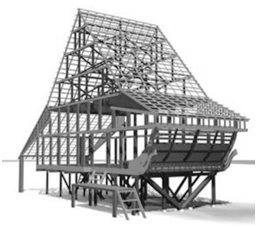
It has been argued that the outer form was inspired by the Dutch merchant ships of the early seventeenth century, this could relate to the influence of the very first trading connections that occurred with the local population and how it left a lasting impression on the society and culture in general. On December 26th 2004 a major earthquake caused a Tsunami in the region of the Indian Ocean. The epicentre of the quake lay offshore the Indonesian Island of Sumatra close to its neighbouring island Nias. 3 months later Nias was again hit by a series of earthquakes causing death of thousands of people. At least 800 people were reported dead, with the possibility of more than 2,000 casualties. Hundreds of buildings were toppled and many thousands of people were made homeless. Whereas, 80 percent of the modern style houses collapsed few old buildings were damaged, causing less harm to the inhabitants. Not as same as the modern style house, the traditional architecture of the Island of Nias is an outstanding example of the adaptation to specific environmental conditions. During the earthquakes in the last months the exceptional stability of the traditional constructions has been proved. Dany Perwita Sari
2nd grade of Master Course of Architecture Engineering

